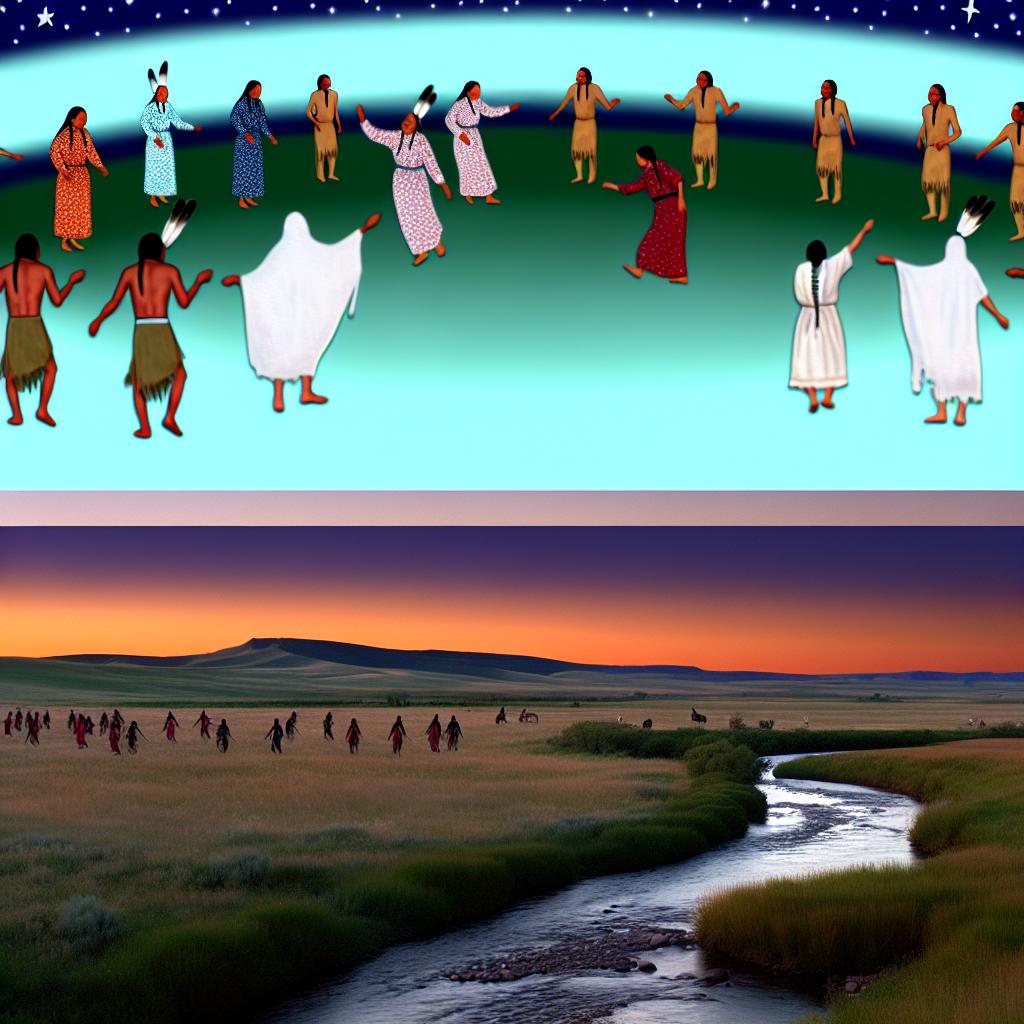The Ghost Dance Movement
The Ghost Dance Movement represents a significant chapter in the history of Native American spirituality and resistance. Emerging in the late 19th century, it was a response to the untenable pressures exerted by the United States government on Native American tribes. This movement was spearheaded by a visionary figure, Wovoka, also known as Jack Wilson. His vision was to restore harmony and peace among Native American tribes, allowing them to live freely in their ancestral lands without the interference of settlers.
Origins and Beliefs
On January 1, 1889, Wovoka, a member of the Paiute tribe, had a profound vision during a solar eclipse. He believed that the path to salvation lay in the revival of traditional Native American practices and spirituality. Wovoka shared with other tribal leaders that through living in peace, practicing cultural rituals, and performing the Ghost Dance, they could invoke change. This dance was more than just a ritual; it was a ceremony to reconnect with ancestors, appealing for their guidance and support in ushering in a new era.
The essence of the Ghost Dance was the belief in an imminent transformation. Wovoka taught that adherence to specific codes of living and participation in the dance would soothe the suffering caused by the spread of settlers and the loss of land and resources. Above all, there was the promise that the buffalo, a vital resource for many tribes, would return to the plains. The Ghost Dance was thus both a spiritual and cultural movement, seeking to undo the damages inflicted by years of colonization.
Spread of the Movement
Wovoka’s teachings resonated across various Native American tribes, such as the Sioux, Arapaho, and Cheyenne. What began as a localized spiritual renewal rapidly expanded into a widespread cultural phenomenon. Each tribe adapted the Ghost Dance to its unique cultural narrative, integrating traditional dances, songs, and rituals.
The movement’s growth can be largely attributed to its message of hope amid adversity. As tribes faced increasing displacement and marginalization, the Ghost Dance offered a glimmer of resistance and the chance for a return to self-determined ways of life. This spreading movement became a binding thread among diverse tribes, uniting them in a shared vision for renewal.
Misunderstanding and Fear
Despite its peaceful intentions, the Ghost Dance was met with suspicion and fear by the U.S. government and many settlers. The passionate gatherings and dances were misunderstood as preparations for an uprising rather than spiritual ceremonies. Authorities saw the potential for organized resistance, failing to appreciate the cultural and spiritual context of the movement.
These misinterpretations led to heightened tensions between Native Americans and the federal government. As settlers spread exaggerated stories of rebellion, the Ghost Dance became a symbol of indigenous defiance, prompting a reactionary posture from the government.
Wounded Knee Massacre
The escalating tensions surrounding the Ghost Dance movement and its perceived implications for settler security reached a tragic climax with the Wounded Knee Massacre on December 29, 1890. This event transpired at the Lakota Pine Ridge Indian Reservation in South Dakota and represents a dark chapter in the history of U.S.-Native American relations.
Prelude to the Massacre
With the Ghost Dance movement gaining momentum, the U.S. government sought ways to assert control and suppress what they incorrectly assumed were rebel activities. The deployment of troops was a calculated measure intended to quell any potential insurrection.
On December 15, 1890, authorities sought to arrest Chief Sitting Bull, a highly respected leader and advocate for the Ghost Dance. His death during the arrest attempt inflamed the already agitated Lakota people. The killing of Sitting Bull underscored the volatility of the situation and served as a grim reminder of the chasm between U.S. authorities and Native American tribes striving to assert their rights and traditions.
The Massacre
Amidst the high-tension environment, approximately 350 members of the Lakota tribe, including women and children, found themselves encircled by the U.S. 7th Cavalry Regiment near Wounded Knee Creek. The intention was to disarm the Lakota, but fear and anxiety hung heavy in the air.
A single gunshot from an unknown source ignited chaos as both sides reacted to the suddenness of the situation. The exchange quickly devolved into violence, as soldiers opened fire on the assembled Lakota. The tragic outcome was the deaths of an estimated 150-300 Lakota people, a situation worsened by the cold and unyielding winter conditions. Known as one of the last significant conflicts in the prolonged series of American Indian Wars, Wounded Knee left a scar on the collective memory of the nation.
Aftermath and Legacy
The aftermath of the Wounded Knee Massacre was characterized by deep sorrow and lasting repercussions for Native American tribes. It came to symbolize both the immense struggle for cultural survival and the extent of disenfranchisement orchestrated through U.S. policies. The massacre was a stark demonstration of the lengths to which the government would go to maintain control over Native populations and suppress self-determination.
In the years that followed, the memory of Wounded Knee has never faded. It remains a poignant symbol of the sacrifices experienced by Native Americans in the face of relentless colonization efforts. Over time, Native communities have commemorated Wounded Knee as part of a broader narrative of resilience and cultural preservation.
Today, Native American communities engage in ongoing efforts to celebrate their heritage. They continue to navigate the complex process of reconciliation and reclaiming autonomy. The Ghost Dance and the events at Wounded Knee serve as significant historical markers in the struggle for cultural revitalization and sovereignty. The narrative of the Ghost Dance Movement endures, encouraging earnest engagement with Native American history and continued advocacy for indigenous rights within contemporary society.

